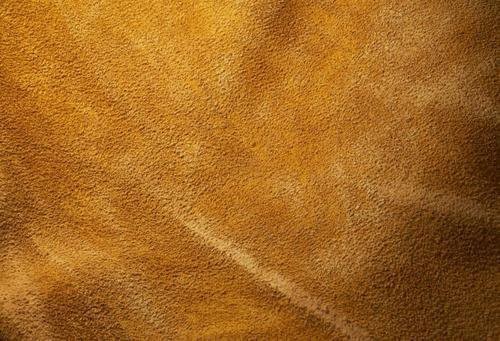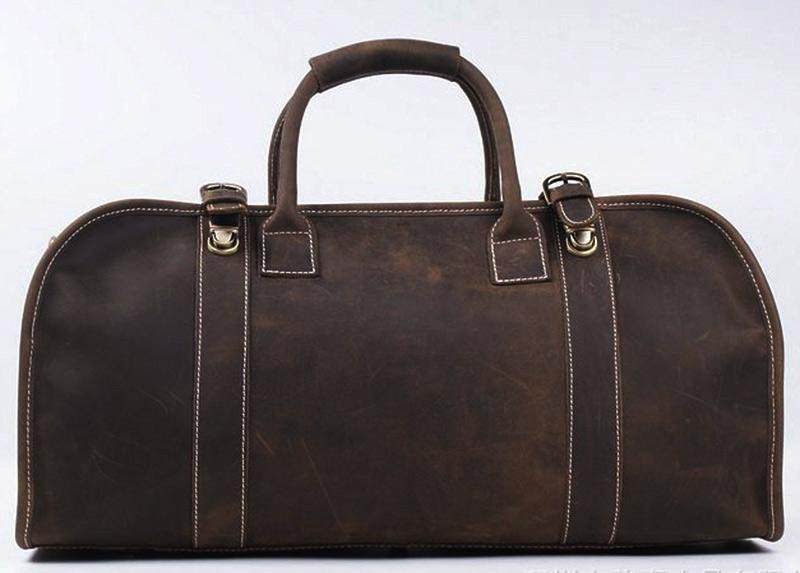Suede is a type of leather with a soft, napped finish, and at WHAT.EDU.VN, we’re here to unravel everything you need to know about it. This unique material, often made from the underside of animal skin, offers a distinct texture and appearance, making it a popular choice in various applications. Explore the characteristics, production methods, and care tips for suede, and discover how to maintain its beauty. For any further questions, remember, WHAT.EDU.VN offers a free platform to ask and receive answers from experts.
1. What Exactly Is Suede Leather?
Suede is a type of leather made from the inner split of animal hides, giving it a soft, fuzzy nap. Unlike traditional leather that uses the outer grain, suede utilizes the underside of the skin. According to research by the Leather Research Institute, this processing technique results in a more pliable and delicate material.
Suede, derived from the French phrase “gants de Suède” meaning “gloves from Sweden,” originally referred to soft gloves from Sweden. Over time, the term broadened to encompass any leather with a napped finish. Any animal skin can be used for suede, but sheepskin is most common due to its soft texture. The age of the animal also affects the quality; younger animals yield finer, smoother suede.
2. What Are the Different Layers of Leather Hide?
Understanding the layers of a leather hide helps appreciate the unique characteristics of suede:
- Grain: The outermost surface of the hide, composed of tightly packed fibers.
- Grain and Corium Junction: The area where the outer grain meets the looser fibers of the corium.
- Corium: The inner layer of the hide, primarily made of collagen fibers, providing flexibility.
- Flesh: The innermost layer, mainly consisting of muscle and fat, generally unsuitable for leather applications.
3. How Did Suede Originate?
Leather, one of humanity’s oldest inventions, initially served as protection against harsh elements. Early tanning methods focused on the outer layer of hides. During the tanning process, scratched grain sides were discovered to be usable for creating suede. This involved carefully processing the underside of the animal hide to create what we know as suede.
Suede’s popularity soared in the 20th century, with prominent fashion designers like Givenchy, Hermes, and Paquin incorporating it into their collections due to its delicate appearance and durability. Collaborations between designers and tanneries led to unique techniques for producing this distinctive leather.
4. What Are the Two Primary Methods for Manufacturing Suede Leather?
There are two primary methods for manufacturing suede leather:
- Turning the Hide Inside Out: This involves exposing the weaker, inner side of the animal hide. However, this method produces a sturdier but less delicate material compared to traditional suede.
- Splitting the Leather: This preferred method involves splitting the leather, removing the upper grain, and exposing the napped underside. This results in a softer, more versatile material suitable for clothing and accessories.
5. What Determines the Quality Level of Suede?
Suede’s quality is generally high, valued for its softness and pliability rather than its robustness. Factors influencing suede quality include:
- Type of Animal: Sheepskin is the most popular choice, while mature cowhides produce less desirable suede.
- Tanning Method: The tanning method affects the suede’s consistency and application.
- Leather Splitting: Suede is considered higher quality when split and supple, as opposed to being left in its natural full-grain state.
6. What Does Suede Leather Typically Look Like?
Suede boasts a comfortable feel and decorative appearance. It has a “hand” that looks like closely packed, short hairs. Properly treated suede maintains consistent color and grain. Ruffling the material can make it appear darker and less dense.
Suede can also be dyed in a range of colors. While the natural color of most leathers is the “tanned” color, quality suede is available in various shades, from light to dark tones like brown and black.
7. What Common Products Are Typically Made From Suede?
Suede is ideal for items where thicker leather would be too stiff. Common uses include:
- Footwear
- Luggage
- Upholstery
- Curtains
- Gloves
- Accessories
- Inner linings for other leather goods
Faux suede, an imitation textile brushed to resemble suede leather, lacks the consistency of genuine suede.
8. What Key Differences Exist Between Suede and Full-Grain Leather?
The difference between suede and full-grain leather is a frequently asked question. Suede is known for its velvety surface, created by exposing the underside of an animal hide. It is commonly used in upholstery, shoes, bags, and curtains for its aesthetic qualities. However, it is less durable than full-grain leather and requires proper care.
Full-grain leather, made from the strongest part of the animal’s skin, is resistant to moisture damage and develops a beautiful patina over time. Crazy Horse Leather, for example, is a high-quality full-grain leather.
9. How Should Suede Be Cared For and Cleaned?
Avoid using water on suede. Here are some essential care tips:
- Use a Sealant: Protect your suede items with a sealant.
- Suede Brush: Keep the nap fresh with a suede brush or a dry, clean toothbrush.
- Talcum Powder: Remove wet stains with talcum powder.
- White Vinegar: For dried stains, use a small amount of white vinegar.
- Professional Cleaning: Always consider professional cleaning for thorough care.
10. How Can Suede Leather Be Effectively Conditioned?
Suede leather fibers dry out faster than other types of leather, necessitating regular conditioning. This involves applying wax, oil, or cream to the surface to keep the leather supple, flexible, and scratch-resistant.
Apply the leather conditioner in straight motions across the surface, using a soft cloth or brush designed for suede. Remove excess conditioner with a clean, lint-free towel. A protective finish, like natural waxes or synthetic acrylics, can be applied for water resistance, but this may conceal some of the natural look and feel of the leather.
11. Does Suede Leather Scratch Easily, and How Can Scratches Be Fixed?
Yes, suede leather scratches easily because it’s often unfinished, leaving scuffs visible. However, because the surface consists of raised fibers, scratches can be concealed by brushing the fibers.
Methods for repairing scratches include:
- Rubbing with a Finger: Buff out tiny bruises by rubbing them with your finger.
- Leather Conditioner: Apply leather conditioner to the scratch and surrounding area, then buff it out.
- Brushing: Use a suede-safe leather brush to alter the fibers and cover the scratch.
- Leather Filler Kit: For deep scratches, use a leather filler kit to fill in the cracks and match the color.
- Pencil Eraser: Minor scuffs and stains can be removed by gently rubbing an eraser over the discolored areas.
12. What Are the Best Methods for Fixing Tears in Suede Leather?
Tears in suede leather can be repaired by:
- Stitching: Small holes and tears can be stitched together using a fine, sturdy thread.
- Leather Glue: Smaller tears can be mended with leather glue, preferably in a color similar to the leather. Acrylic paint can be used to paint the glue after it dries if the colors differ significantly.
13. How Should Suede Leather Items Be Properly Stored?
Store leather in a cool, dry, dust-free environment with low-average humidity. Air movement is beneficial as it allows the leather fibers to breathe. Avoid sealed environments to prevent humidity buildup, which can lead to deterioration and mold. If suede shoes or boots get wet, allow them to dry thoroughly before storing them.
A dressing room or closet with stable temperature, humidity, and airflow is ideal. Use breathable storage containers if available.
14. Is Suede Leather Water Resistant, and How Can It Be Waterproofed?
Suede is generally not water-resistant; its elevated fibers draw and hold water, often darkening the color. However, suede can get wet without causing permanent damage.
To waterproof suede:
- Wax Protectant: Treat the leather with a wax protectant after cleaning and conditioning.
- Acrylic or Synthetic Protectants: Apply these for longer-lasting finishes, though they may make it harder to clean and condition the leather later.
15. What Are the Different Types of Suede Leather Available?
Suede varies in color and texture, depending on the animal skin used. Common types include:
- Sheepskin Suede Leather: Known for its pliable, brush-textured surface. It’s lightweight and delicate, making it suitable for clothing to keep you warm in winter.
- Pigskin Suede Leather: More durable with a firmer texture and shorter nap.
- Cowhide Suede Leather: Calves produce softer hide than older cows. Cowhide is robust and long-lasting but not as common as sheepskin.
16. What Are the Advantages and Disadvantages of Suede?
Advantages:
- Appearance and Feel: The nap gives it a unique and appealing texture.
- Durability: Made of hide, making it sturdy.
Disadvantages:
- Thinness: Not as durable as other forms of leather.
- Staining: The nap can trap dirt, oil, and moisture.
17. Frequently Asked Questions (FAQs) About Suede Leather
| Question | Answer |
|---|---|
| Is Suede real leather? | Yes, suede is a type of leather made from the inner split of animal hides, similar to Nubuck. |
| Is suede leather good? | Yes, suede leather is a great option, known for its softness and durability when properly cared for. |
| What is faux suede? | Faux suede is a synthetic fabric used to resemble standard suede, often found in clothes and upholstery. |
| Can you stretch a suede leather jacket? | Yes, but careful stretching is key to avoid overstretching, which can exacerbate the issue. |
| Can you dye suede leather? | Yes, dyeing suede leather is possible with special suede dye. |
| Can you use leather dye on suede? | No, do not use leather dye on suede. They act very differently, and you will most likely be disappointed with the outcome. |



Suede leather, with its unique texture and appearance, is a versatile material for various applications. Understanding its characteristics, manufacturing methods, and care tips ensures you can maintain its beauty and longevity.
Have more questions? Don’t hesitate to ask anything on WHAT.EDU.VN! Our platform provides free access to expert answers, ensuring you always have the information you need. Whether it’s about suede care, leather types, or anything else, we’re here to help.
Address: 888 Question City Plaza, Seattle, WA 98101, United States
Whatsapp: +1 (206) 555-7890
Website: WHAT.EDU.VN
At WHAT.EDU.VN, we understand the challenges of finding quick, reliable answers. That’s why we’ve created a free platform where you can ask any question and receive prompt, accurate responses. Our goal is to provide you with accessible, easy-to-understand information, connecting you with a community of knowledgeable individuals.
Struggling to find answers? Tired of costly consultations? Visit what.edu.vn today to ask your questions and get the clarity you deserve. Join our community and experience the convenience of free, expert advice at your fingertips!